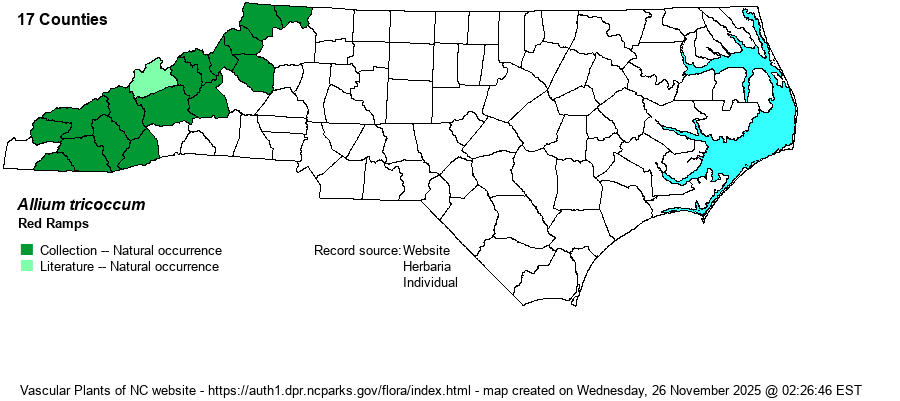| Section 5 » Order Liliales » Family Alliaceae |
Show/Hide Synonym
| taxonName | relationship | relatedTaxonName | relatedTaxonRefText | relComments |
|---|
|
|
|
| Allium tricoccum | < | Allium tricoccum | Fernald (1950) | | | Allium tricoccum | < | Allium tricoccum | Gleason (1952) | | | Allium tricoccum | < | Allium tricoccum | | | | Allium tricoccum | < | Allium tricoccum | Flora of Virginia | | | Allium tricoccum | = | Allium tricocum var. tricoccum | Gleason and Cronquist (1991) | | | Allium tricoccum | = | Allium tricocum var. tricoccum | Flora of North America (1993b, 1997, 2000, 2002a, 2002b, 2003a, 2004b, 2005, 2006a, 2006b, 2006c, 2007a, 2009, 2010) | | | Allium tricoccum | = | Validallium tricoccum | Small (1933, 1938) | | | Source: Weakley's Flora |
|
| Author | Aiton | |
| Distribution | This well known species (to "mountaineers") ranges across all of the Mountains, mainly at middle and high elevations, though a few counties there lack collections. It does not occur downstate.
This is a Northeastern species, ranging across eastern Canada south to NJ, PA, and MO, and then south mainly in the Appalachians and Cumberlands to extreme northern GA and northeastern AL. It has yet to be found in SC, as elevations there may be too low. | |
| Abundance | Fairly common to frequent but somewhat local. You may walk over a number of mountainsides and coves without seeing it, but then on another it can be quite abundant. The species is harvested in some numbers for various ramp(s) festivals in the spring, as eating the bulb is considered a delicacy to some people, though certainly not to many others! It is most numerous above 3500 feet elevation and is scarce at the low elevations (below 2500 feet). | |
| Habitat | This is a species of rich forested mountainsides, favoring Rich Cove Forests but also found in Northern Hardwood Forests and other mesic slopes. |
| Phenology | Blooms in June and July, and fruits from August to September. Note that the paired leaves emerge in spring (April) and thus are harvested before a flowering stalk appears. | |
| Identification | This species looks quite a bit like many other monocot species when in leaf, though those who collect it for festivals certainly know how to identify it at that stage, even without pulling a plant out of the ground to see the bulb. Each plant has two somewhat narrowly elliptical leaves that grow to about 6-9 inches long, but about 2 inches wide, and thus clearly not linear or strap-shaped like many monocots. The leaves are often rather thick and shiny. Interestingly, the leaves wither and disappear by late May or early June, such that the flowering stalk is present without any leaves visible! This naked stem grows to about 9-10 inches high, topped by an erect (not nodding) umbel of fairly small cream to pale yellow flowers. It can be easily confused with a sister species -- A. burdickii, which has been collected from the NC mountains only a few times in Haywood County. This latter species has narrower leaves, often just 1 inch wide or less, the leaf has essentially no petiole, the basal portion of the leaf is white, and it has many fewer flowers (often 10-18). A. tricoccum has leaves with a distinct petiole base, which is reddish or pink, and it has more flowers in the umbel (often 30-55). Many biologists and wildflower enthusiasts visit the mountains in late April and May to see the spring floral display, and they may come across a huge stand of leaves of the species, especially as it can grow in dense and large colonies. Sadly, fewer people get to see it in bloom, later on in June and July, as this is a time of much fewer species in bloom in cove forests and other rich slopes. | |
| Taxonomic Comments | Though this is a good species, some references treat A. burdickii as a taxon within it; these references thus name Red Ramps as Allium tricoccum var. tricoccum and White Ramps or Narrowleaf Ramps as Allium tricoccum var. burdickii.
| |
| Other Common Name(s) | Ramps, Wild Leek, Rampscallions. Note that the common name is often listed simply as Ramp or Red Ramp, without the plural name. | |
| State Rank | S4 | |
| Global Rank | G5 | |
| State Status | | |
| US Status | | |
| USACE-agcp | FACU link |
| USACE-emp | FACU link |

